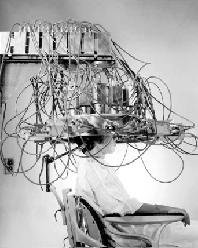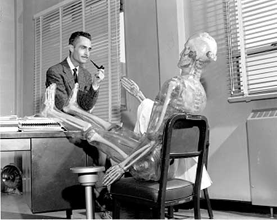
the truth out there


|
The seemingly ever-lasting appeal of conspiracy theories and alleged government cover-ups may have reached its zenith. TV-shows and movies incorporating conspiracy/cover-up themes--from JFK and Mission Impossible to the X-Files, Independence Day and Men in Black--have been commercially successful, especially when they feature aliens or paranormal activities. Maybe it's an outlet for the fear and uncertainty created by the dusk of the millennium. Or maybe there's something comforting about the belief in conspiracy or cover-up: the thought that there's a plot out there is a far more reassuring alternative than to imagine a random game of history that makes individuals victims of chance. Unless you are the hero trying to unearth the information "They" (preferably the government) are keeping from you, the conspiracy theories also distract from addressing facts. It's less distressing to worry about Aliens than Aids. Believing that one can never get to the truth is often easier than dealing with the truths that are already "out there." Ironically, "declassified" information tends to be more shocking to the public than what is labeled "classified." Some of the declassified information addressing controversial chapters in U.S. history has been made available online by the U.S. Department of Energy (DOE) and The Brookings Institution. In March 1994, the DOE established the Office of Human Radiation Experiments as the leading force behind the DOE's efforts to tell the agency's Cold War story of radiation research using human subjects. In an intensive endeavor to make information available, the Office of Human Radiation Experiments identified and catalogued relevant historical documents from DOE's 3.2 million cubic feet of records scattered across the country; these resources are now available online. The "Human Radiation Experiments" website features historically significant documents that provide an overview of DOE (and predecessor agencies') activities relating to human radiation experiments. The online resources include an experiments list, oral histories, declassified documents as well as the final report of the Advisory Committee on Human Radiation Experiments (ACHRE), which was appointed by President Clinton in 1994 to investigate reports of possibly unethical experiments funded by the government decades ago. The site's multimedia section gives visitors access to sound bytes, film clips demonstrating experiments (coming soon) and historical photographs. The experiments list describes over 400 human radiation experiments conducted from the early 1940s through the early 1970s; the list is limited to experiments supported by DOE, its predecessor agencies, or agency contractors. Beginning in the late 1940s, hundreds of hospitals and other institutions worked with radionuclides and radioactively labeled compounds, and much of this work involved human radiation experiments. Since DOE and its predecessors had no active role in most of these experiments--apart from distributing licenses and isotopes--they are not included in the list and a lot of information remains in the dark. However, many experimental treatments for diseases such as cancer involved the use of radiation and, over time, a variety of these therapies developed from the experimental stages into routine procedures; it is difficult to determine at what point the treatments ceased to be experimental. The website's oral history section holds an eerie fascination. It features transcripts of interviews conducted by historians who traveled around the country for the DOE to talk to researchers and others possessing firsthand knowledge of the human radiation experiments that occurred during World War II and the years of the Cold War. The interviewers sought to elicit missing information and to provide the researchers they talked to with a venue for both reflecting on their past activities and responding to the criticisms these activities have engendered. The transcripts are the stuff movies are made of and sometimes give the sense of an elaborate government cover-up. Of course, the interviews can most effectively illuminate the personal and ethical conflicts involved in this controversial chapter of U.S. history.  Los Alamos chemist Wright Langham and a "plastic man" used to simulate human radiation exposure.Another effort to critically reflect on government activities has been undertaken by The Brookings Institution with its "Atomic Audit: The Costs and Consequences of U.S. Nuclear Weapons Since 1940." Financed largely by endowments and also through the support of philanthropic foundations, corporations, and private individuals, The Brookings Institution functions as an independent analyst and critic, committed to making its findings accessible to the public. "Atomic Audit" strives to trace the history of U.S. nuclear weapons and to unearth the comprehensive costs of their infrastructure--design and fabrication facilities; command, control, and communications networks; the eventual dismantling of weapons systems and the management of toxic and radioactive wastes accumulated over decades. Since 1945, the United States has manufactured and deployed more than 70,000 nuclear weapons "to deter" nuclear war. (By 1950, nuclear weapons were considered relatively inexpensive--"a bigger bang for the buck.") The perceived and actual threats that laid the foundation for the Cold War and the fact that a nuclear war didn't happen have contributed to the widely held opinion that investment in nuclear weapons was a prudent insurance policy. "Atomic Audit" analyzes the assumptions behind and the consequences of the expenditures. The study demonstrates that systems (military ones, in particular) tend to develop their own dynamics; it shows how a variety of factors--the indeterminate requirements of deterrence and faulty assumptions about the cost-effectiveness of nuclear weapons; regular misrepresentation of and overreaction to the Soviet (and later Chinese) threat; bureaucratic, often arbitrary decisions as well as excessive secrecy--have led to the acquisition of an arsenal far larger than what many people, civilian and military, deem necessary. The impressive array of information accessible at the "Atomic Audit" site includes "Historical and Proposed Spending on Nuclear Weapons Research, Development, Testing, and Production, 1948-2003," "Global Nuclear Weapons Tests and Global Nuclear Stockpiles, 1945-1996," as well as "Top 10 Least Accountable U.S. Nuclear Weapons Programs" and "50 Facts About U.S. Nuclear Weapons." The latter list includes the following items: --Number of thermometers that could be filled with mercury used to produce lithium-6 at the Oak Ridge Reservation: 11 billion --Legal fees paid by the DOE to fight lawsuits from workers and private citizens concerning nuclear weapons production testing activities, from October 1990 through March 1995: $89,000,000 --Number of U.S. nuclear bombs lost in accidents and never recovered: 11 --Minimum number of classified pages estimated to be in the DOE's possession: 280 million Browsing the information at the DOE's and the "Atomic Audit" site may make you wish that you were reading nothing but the paranoid delusions of a devoted conspiracy buff. |